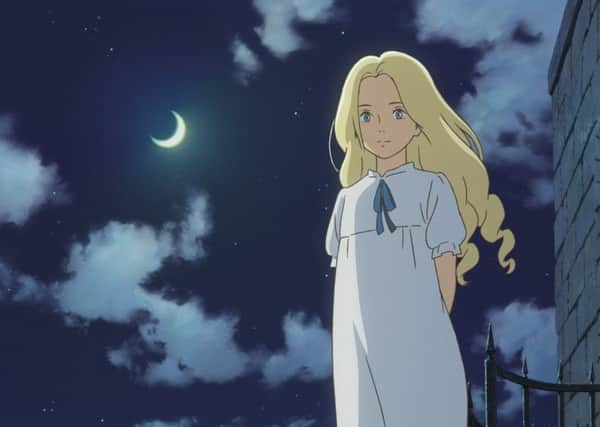Film review: When Marnie Was There | Mother's Day | Where To Invade Next


Rumoured to be the last ever Studio Ghibli film produced entirely in-house, When Marnie Was There (****) feels like an appropriate swansong for the legendary Japanese animation studio’s insular way of working. An adaptation of Joan G Robinson’s classic children’s book of the same name, it marks another subtle stylistic shift away from the wilder flights of imagination found in the likes of Spirited Away, yet it maintains a strong connection to that celebrated heritage – something reflected in the way this tale of a melancholic young girl’s secret friendship with the mysterious Marnie becomes a haunting meditation on the past and its hold on the present. That theme emerges as the introverted, artistic and not-always-nice-heroine, Anna, is sent away by her foster mother for a seaside holiday with some relatives. Her sense of isolation already intensified by the discovery that her guardian receives money from the state to look after her, Anna becomes obsessed with the titular blonde-haired girl who lives in the dilapidated mansion across the salt marshes from her adoptive relatives’ house. Sneaking out at night, Anna and Marnie meet for what seem like innocent trysts in the moonlight, forming a deep and loving bond that appears to transcend space and time and becomes increasingly complicated as Anna starts to have doubts about Marnie’s physical existence. The more the film ratchets up this spectral dimension of the story, the more it reflects the intense emotions of its young protagonist, something director Hiromasa Yonebayashi signifies with overcast skies and mood-reflective interiors. Although the film doesn’t quite wrap up the central mystery with the same degree of elegance, it does end with a hopeful message about learning to be comfortable in your own skin, something the switched-on kids who seem to devour Studio Ghibli’s offerings will likely lap up.
In the end-credit blooper reel of the woeful Mother’s Day (*) there’s a magnificent shot in which Pretty Woman director Gary Marshall accidentally achieves what Werner Herzog calls “the ecstatic truth”. It features Julia Roberts – cast as a home shopping television maven – sitting in a diner looking morose. Her character has just been reunited with the daughter she gave up for adoption and is supposed to be contemplating her life choices, but a freight train is rolling by in the background of the shot, ruining the scene. Roberts is a professional, though, so like a trooper, she keeps her character’s emotional pain etched on her visage as she patiently waits for the train to pass. But it never does. Carriage upon carriage rolls by and even though Roberts starts swearing under her breath, all through the take her face remains fixed in a grimace of pain. That pretty much sums up the experience of watching the preceding two hours. Following Valentine’s Day and New Year’s Eve, it’s another interminable ensemble vomit fest built around a holiday that serves no real purpose other than providing the film with an arbitrary catalyst for a bunch of mostly white and wealthy dullards to have emotional meltdowns. Alleged comedy relief comes in the form of racist jokes and gags about the male fear of sanitary products. You have been warned.
Advertisement
Hide AdMichael Moore has a bit of a fixed grin on his face for much of Where To Invade Next (***), the consistently jocular tone of which belies the obvious anger he continues to feel at the ongoing decline of his home country. Taking America’s propensity for launching unsuccessful invasions for natural resources as his starting point, he decides to head to Europe to plunder all the best ideas for the creation of an America that might actually start living up to its stated ideals. As he marvels with faux naivety at how much more progressive each country he visits seems, it’d be easy to criticise Moore for ignoring their own complex social problems. But that’s not the point. In asking why some of these ideas can’t be implemented in a wealthy country that doesn’t do a good enough job of looking after its citizenry, he’s shining a timely light on the degree to which the current system is out of whack.
Of course one reason why a fairer society is doomed is humanity’s inherent awfulness, something illustrated in The Stanford Prison Experiment (****), Kyle Patrick Alvarez’s quietly horrifying dramatisation of the infamous 1971 university study in which a group of volunteer students were placed in a simulated prison environment – half of them cast as guards, the other half as inmates. The experiment was supposed to last two weeks, but started going horribly wrong after the first day. Cranking up the tension by gradually moving his camera in closer and closer to his actors, Alvarez smartly shrinks the distance between them and us in order to intensify the what-would-you-do? discomfort the experiment was designed to explore.
Embrace the Serpent (****) also deals with civilisation’s more deplorable aspects. It’s a fictionalised account of the travel journals of ethnographers Theodor Koch-Grünberg and Richard Evans Schultes, who journeyed to the Amazon decades apart and inadvertently documented the elimination of various indigenous tribes. Mercifully, Ciro Guerra’s film is not another Heart of Darkness-style meditation on the so-called white man’s burden. Shot in majestic black and white, it’s an elegiac inversion of that trope, told from the point of view of the shaman (played as a young man by Nilbio Torres and as an older man by Antonio Bolívar Salvador) who guides both men up the serpent-like river. Seen through his yes, the film leaves you in little doubt which society is the less civilised.